|
"When it's time to choose the
right flooring for your home or business, know your options."
Carpet
For warmth and softness underfoot, carpet is your
choice. Carpet has two components -- face pile and backing. Because the face
pile (or yarn fibers) is subject to all the wear and tear, it's your key
consideration. Backing is almost never seen once the carpet is installed,
but it plays a role in the overall quality. Any carpet measuring more than
54 inches wide is referred to as "broadloom."
Carpet face pile comes in two variations: cut and
loop. In cut-pile carpets, individual yarns stand up straight from the
backing. In loop-pile construction, the yarn comes out of the backing, loops
over, and returns into the backing. Loop-pile carpets with a level surface
are called level loops. If the loop height varies, the carpet is a
multilevel loop. Most loop piles will perform better than cut piles over the
long haul because the loops help evenly distribute the impact of foot
traffic. One caveat: Loose loop-pile products, such as berbers, won't hold
up as well under heavy traffic, especially if they are made with
polypropylene, a less-resilient fiber. Cut-and-loop, or cut/uncut, carpets
combine both pile types to add surface texture, and often blend multiple
yarn colors. Sometimes referred to as "sculptured," these multitexture,
multicolor carpets hide footprints and soil well.
|
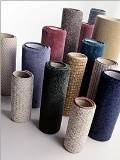 |
Generally, the heavier the carpet, the better it will hold up. However,
don't select a product based on weight alone. Consider the carpet's density,
pile height, and fiber type when comparing different varieties. Many carpets
come in good, better, and best choices. These will be similar styles
available in the same colors. The difference is usually weight. A retailer
might offer a textured saxony in 28, 34, and 40 ounces, for example. If
you're budget-conscious, select the heavier product for high-traffic areas
and the lower-weight carpet for less-used rooms. |
| |
Hardwood
Hardwood lasts longer than other flooring options and can be refinished
several times (solid hardwoods can be refinished an unlimited number of
times) -- or even restained to change their appearance. Today's polyurethane
finishes allow installation in kitchens and half baths, as long as you take
precautions to minimize water spills. Engineered woods are considered more
stable for kitchen and bath applications. Wood flooring is available in
strips, planks, and parquet squares.
|
| |
Unfinished flooring gives you almost
unlimited color stain options. The drawback: Unfinished flooring
must be sanded and finished after installation, which typically
requires the expertise of a professional and puts the room out of
service for several days. Prefinished flooring features a
factory-applied finish that remodelers sometimes favor because it
eliminates sawdust and finish vapors, and the room can be used
within 24 hours after installation. The color options for
prefinished flooring are not as varied as for unfinished flooring. |
 |
| |
Solid or engineered flooring consists of two or more layers of
wood, similar to plywood. The top layer consists of a hardwood veneer,
while the lower layers are typically softwood. Unlike engineered wood
flooring, the most familiar wood flooring is comprised of solid
one-piece boards. Most solid flooring is unfinished, while most
engineered flooring is prefinished. |
Laminate
|
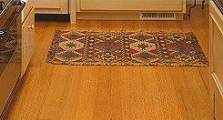 |
Laminate
flooring features a decorative image printed on one or more thin
sheets of paper or other fibrous material. For durability, the
decorative layer is impregnated with a plastic or resin, bonded to a
rigid core, and then a backing material is added to prevent warping.
The most popular location for laminate is in the kitchen; family
rooms, foyers, and dining rooms
are runners-up.
Because the image printed on the paper layer is actually a
photograph, laminate floors truly look like wood, stone, or other
materials and come in a range of colors and patterns. Laminates
sometimes sound hollow when they're walked upon. To solve the
problem, some manufacturers offer underlayments that help deaden
sound. |
| |
|
|
Ceramic
tile
Ceramic tile is suitable for use anywhere you want a durable,
low-maintenance floor. This is especially true of moisture-prone,
heavy-traffic areas such as bathrooms, mudrooms, entryways, and
kitchens. Ceramic tiles come in almost unlimited colors, patterns,
shapes, and sizes.
Ceramic tile falls into four basic categories: quarry tile, paver
tile, patio tile, and glazed tile. The body of a tile, sometimes
called the bisque or biscuit, is produced to meet a specific need or
use. Although thickness is one gauge of strength, composition of the
tile and the temperature and duration of firing also determine its
strength.
|
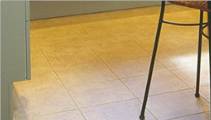 |
|
|
Vinyl
Vinyl floor coverings are durable and suitable for any room in
the house. You'll find vinyl available as sheets or tiles in two
categories.
Rotogravure vinyl features a knobby texture as well as
pattern and color printed on the finish side only. This knobby
texture can be difficult to clean.
Inlaid vinyl features pattern and color through the
thickness of the material. It's typically much more durable than
rotogravure vinyl and will look good and last for many years.
Sheet vinyl is a popular choice for bathrooms, kitchens,
laundry rooms, entryways, hallways, and rec rooms. It comes in many
patterns and styles.
Vinyl tiles can be used in many of the same applications;
however, dirt-collecting seams can make a vinyl tile floor difficult
to keep clean. And the same joints can allow liquid spills to filter
between tiles, loosen them, and damage the subfloor.
|
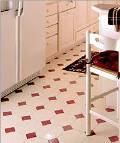 |
|
|
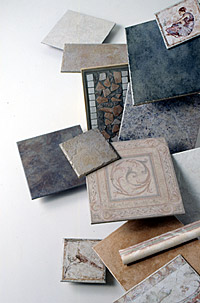 |
No matter what flooring material you
choose, it should be serviceable for your lifestyle. Take the following
into account before you decide:
- Cleanability. For easy-care flooring, choose vinyl,
laminate, or ceramic tile -- smooth surfaces that clean up with a
sweep and a rag. Other materials will require a bit more upkeep to
maintain their good looks.
- Durability. With the ability to endure an onslaught of
abuse from children, pets, and heavy traffic, ceramic and stone tile,
laminate, and concrete rank at the top. Although marks will show on
hardwood, the surface can be refinished.
- Longevity. Standing the test of time are stone and ceramic
tiles, hardwood, cork, and concrete. Most other flooring materials
will eventually need replacing.
- Moisture resistance. For rooms prone to highly humid
conditions, such as kitchens and baths, use materials that are more
water-resistant, such as tile, vinyl, and certain types of laminate
(check manufacturers' warranties).
- Allergens. If you're particularly sensitive and concerned
about your home's indoor air quality, choose a hard flooring material,
such as ceramic tile or hardwood, that contains few crevices or
grooves to harbor dust mites and allergens.
|
| |
Below you will find just
some of the brands Kenny's
sells. Click in any of the logos
below for more information a new
page will open on their website.
|
|
|
| |
You can stop the
scroll bar by putting your
cursor in the center or speed it
by putting it on the right
side reverse it by putting your cursor
on the left side. |
|
|
|
|